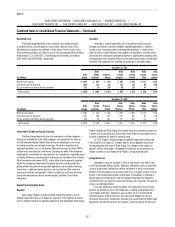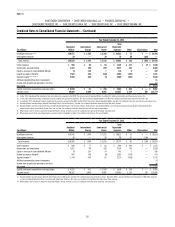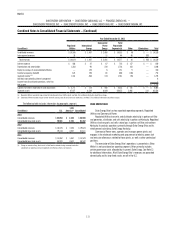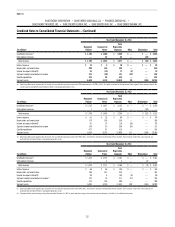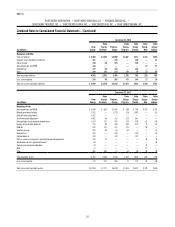Duke Energy 2013 Annual Report Download - page 123
Download and view the complete annual report
Please find page 123 of the 2013 Duke Energy annual report below. You can navigate through the pages in the report by either clicking on the pages listed below, or by using the keyword search tool below to find specific information within the annual report.
105
PART II
DUKE ENERGY CORPORATION • DUKE ENERGY CAROLINAS, LLC • PROGRESS ENERGY, INC. •
DUKE ENERGY PROGRESS, INC. • DUKE ENERGY FLORIDA, INC. • DUKE ENERGY OHIO, INC. • DUKE ENERGY INDIANA, INC.
Combined Notes to Consolidated Financial Statements – (Continued)
Duke Energy, through its captive insurance entities, also has reinsurance
coverage with third parties for certain losses above a per occurrence and/or
aggregate retention. Receivables for reinsurance coverage are recognized when
realization is deemed probable.
Unamortized Debt Premium, Discount and Expense
Premiums, discounts and expenses incurred with the issuance of
outstanding long-term debt are amortized over the term of the debt issue. Call
premiums and unamortized expenses associated with renancing higher-cost
debt obligations used to nance regulated assets are amortized. Amortization
expense is recorded as Interest Expense in the Consolidated Statements of
Operations and is reected as Depreciation, amortization and accretion within
Net cash provided by operating activities on the Consolidated Statements of
Cash Flows.
Loss Contingencies and Environmental Liabilities
Contingent losses are recorded when it is probable a loss has occurred
and can be reasonably estimated. When a range of the probable loss exists and
no amount within the range is a better estimate than any other amount, the
minimum amount in the range is recorded. Unless otherwise required by GAAP,
legal fees are expensed as incurred.
Environmental liabilities are recorded on an undiscounted basis when
environmental remediation or other liabilities becomes probable and can be
reasonably estimated. Environmental expenditures related to past operations
that do not generate current or future revenues are expensed. Environmental
expenditures related to operations that generate current or future revenues are
expensed or capitalized, as appropriate. Certain environmental expenditures
receive regulatory accounting treatment and are recorded as regulatory assets.
See Notes 4 and 5 for further information.
Pension and Other Post-Retirement Benefit Plans
Duke Energy maintains qualied, non-qualied and other post-retirement
benet plans. Eligible employees of the Subsidiary Registrants participate in the
respective qualied, non-qualied and other post-retirement benet plans and
are allocated their proportionate share of benet costs. See Note 21 for further
information, including signicant accounting policies associated with these
plans.
Severance and Special Termination Benefits
Duke Energy has an ongoing severance plan under which, in general,
the longer a terminated employee worked prior to termination the greater the
amount of severance benets. A liability for involuntary severance is recorded
once an involuntary severance plan is committed to by management, or sooner,
if involuntary severances are probable and can be reasonably estimated. For
involuntary severance benets incremental to its ongoing severance plan
benets, the fair value of the obligation is expensed at the communication date
if there are no future service requirements, or over the required future service
period. From time to time, Duke Energy offers special termination benets
under voluntary severance programs. Special termination benets are recorded
immediately upon employee acceptance absent a signicant retention period.
Otherwise, the cost is recorded over the remaining service period. Employee
acceptance of voluntary severance benets is determined by management
based on the facts and circumstances of the benets being offered. See Note 19
for further information.
Guarantees
Liabilities are recognized at the time of issuance or material modication
of a guarantee for the estimated fair value of the obligation it assumes. Fair
value is estimated using a probability-weighted approach. The obligation is
reduced over the term of the guarantee or related contract in a systematic and
rational method as risk is reduced. Any additional contingent loss for guarantee
contracts subsequent to the initial recognition of a liability is accounted for and
recognized at the time a loss is probable and can be reasonably estimated. See
Note 7 for further information.
Stock-Based Compensation
Stock-based compensation represents costs related to stock-based
awards granted to employees. Duke Energy recognizes stock-based
compensation based upon the estimated fair value of awards, net of estimated
forfeitures at the date of issuance. The recognition period for these costs begin
at either the applicable service inception date or grant date and continues
throughout the requisite service period, or for certain share-based awards
until the employee becomes retirement eligible, if earlier. Compensation cost
is recognized as expense or capitalized as a component of property, plant and
equipment. See Note 20 for further information.
Income Taxes
Duke Energy and its subsidiaries le a consolidated federal income
tax return and other state and foreign jurisdictional returns. The Subsidiary
Registrants entered into a tax-sharing agreement with Duke Energy and income
taxes recorded represent amounts the Subsidiary Registrants would incur
as separate C-Corporations. Deferred income taxes have been provided for
temporary differences between GAAP and tax bases of assets and liabilities
because the differences create taxable or tax-deductible amounts for future
periods. Deferred taxes are not provided on translation gains and losses when
earnings of a foreign operation are expected to be indenitely reinvested.
Investment tax credits (ITC) associated with regulated operations are deferred
and amortized as a reduction of income tax expense over the estimated useful
lives of the related properties.
Positions taken or expected to be taken on tax returns, including the
decision to exclude certain income or transactions from a return, are recognized
in the nancial statements when it is more likely than not the tax position can
be sustained based solely on the technical merits of the position. The largest
amount of tax benet that is greater than 50 percent likely of being effectively
settled is recorded. Management considers a tax position effectively settled
when: (i) the taxing authority has completed its examination procedures,
including all appeals and administrative reviews; (ii) the Duke Energy
Registrants do not intend to appeal or litigate the tax position included in the
completed examination; and (iii) it is remote the taxing authority would examine
or re-examine the tax position. The amount of a tax return position that is not
recognized in the nancial statements is disclosed as an unrecognized tax
benet. These unrecognized tax benets may impact the nancial statements









